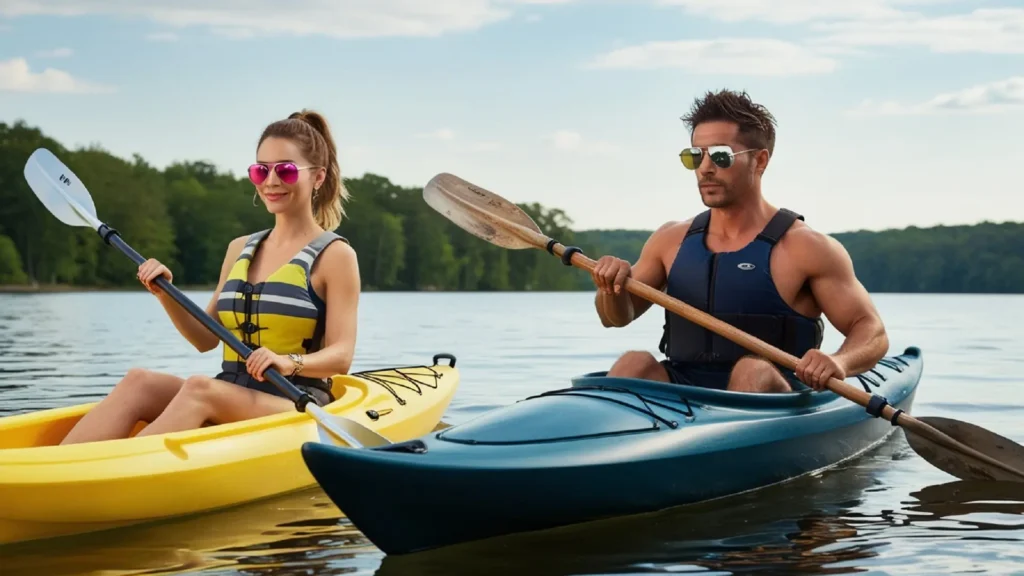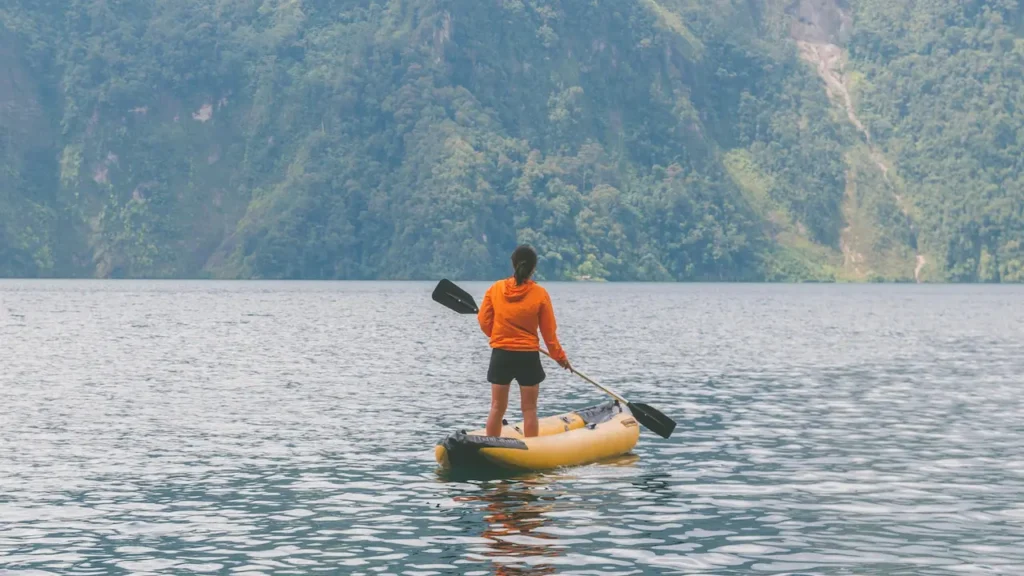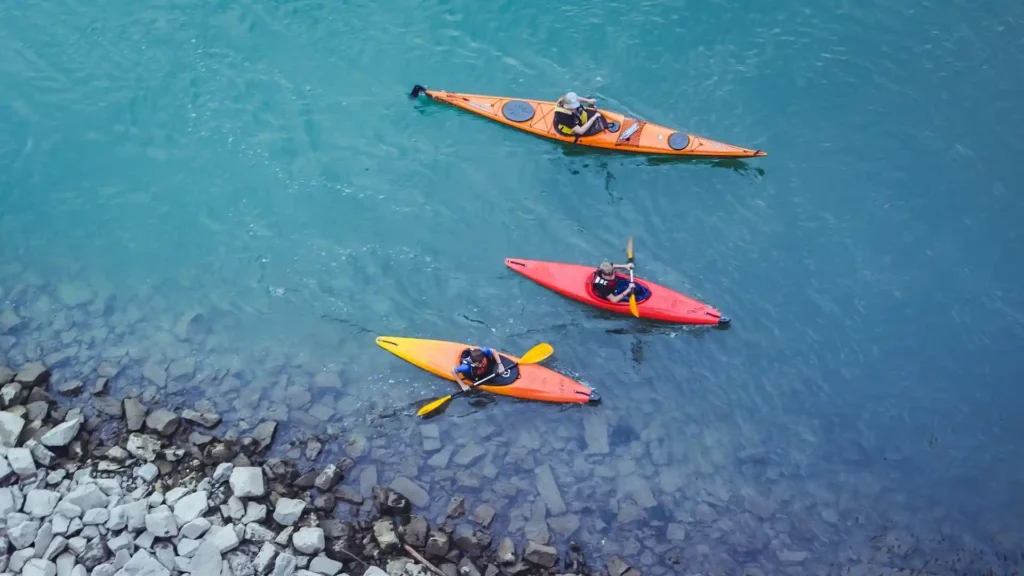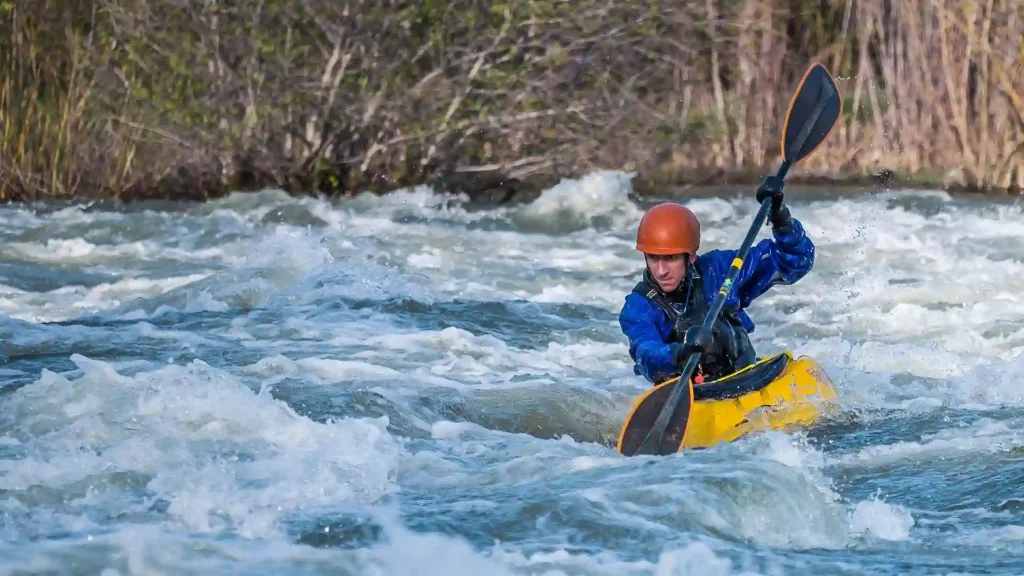After reading this article, your confusion will be removed when choosing the right kayak –sit-on-top or sit-in- for you. Both types offer distinct advantages and are suited to different types of paddling experiences.
Understanding the key differences between these two designs can help you make an informed decision based on your skill level, intended use, and personal preferences.
In this article, we’ll compare sit-on-top and sit-in kayaks across several important features, such as stability, comfort, ease of use, and performance.
Design and Structure
Sit-on-Top Kayaks | Sit-in Kayaks |
As the name suggests, sit-on-top kayaks have an open deck where the paddler sits on top, rather than inside the kayak. These kayaks are typically designed with self-draining scupper holes that allow water to flow off the deck. This keeps the paddler dry and prevents water from accumulating inside the boat. They feature wider, more stable hulls, making them a great choice for beginners and recreational paddlers. The open design also allows for easier entry and exit. This design helps to launch from a beach or get back on the kayak after a fall into the water. | In contrast, sit-in kayaks have an enclosed cockpit where the paddler sits inside the boat. The cockpit is typically surrounded by a rim that can be sealed with a skirt, which helps prevent water from entering the kayak during paddling. Sit-in kayaks tend to have more streamlined hulls, which often provide better speed and maneuverability than their sit-on-top counterparts. The enclosed design offers more protection. Sit-in kayaks are ideal for cold-weather conditions or for paddling in rough waters where wind and water can splash into the boat. |
Stability and Ease of Use
Sit-on-Top Kayaks | Sit-in Kayaks |
Sit-on-top kayaks are generally more stable than sit-in kayaks.
Their wider, flatter hulls make them less prone to tipping over. Additionally, the open design provides a lower center of gravity, enhancing stability even further. These kayaks are very forgiving when it comes to balance, so they’re well-suited for calm lakes, rivers, and coastal paddling. However, their increased stability can sometimes result in slightly slower performance compared to sit-in kayaks. | Sit-in kayaks, with their narrower and more streamlined hulls, tend to be less stable, but they offer superior performance in terms of speed and agility. The higher center of gravity can make them a bit more challenging for beginners to balance, but skilled paddlers can navigate rough waters more effectively with a sit-in design. Despite being less stable on calm waters, sit-in kayaks are better suited for choppy or turbulent conditions, as they offer greater control and responsiveness in more dynamic environments. |
Comfort and Fit
Sit-on-Top Kayaks | Sit-in Kayaks |
Sit-on-top kayaks have no cockpits, so no tight space. They provide a more relaxed and comfortable seating arrangement. The seat is usually a molded area with padding or a removable seat cushion for extra comfort. You have more legroom and can move around easily if needed. However, some paddlers may find sit-on-top kayaks less comfortable for longer trips, especially if they are exposed to the sun for extended periods, as there’s little protection from the elements. | Sit-in kayaks tend to offer a more snug and supportive fit, as you are sitting inside the cockpit. This can be more comfortable for longer paddles, particularly in cooler conditions, as the design offers some protection from wind and rain. Additionally, a well-designed cockpit and adjustable seat allow for better control and a more ergonomic posture. However, getting in and out of a sit-in kayak can be trickier than a sit-on-top, especially for beginners, and some may find the confined space uncomfortable during hot weather. |
Safety and Self-Rescue
Sit-on-Top Kayaks | Sit-in Kayaks |
One of the major advantages of sit-on-top kayaks is their self-rescue capabilities. If you tip over (which is less common due to their stability), you can easily climb back on without needing to empty the kayak or perform complicated re-entry techniques. The open design makes it straightforward to get back on the boat and continue paddling. This feature makes sit-on-top kayaks popular for recreational activities like fishing, where it’s common to be in and out of the water, or for beginners who are learning the basics of kayaking. | While sit-in kayaks are slightly more prone to capsizing due to their narrower design, they offer better overall control in rough water. However, if you do flip, the process of self-rescue can be more complicated. You’ll need to perform a wet exit (removing yourself from the kayak) and then either swim the kayak to shore or attempt a re-entry, which can be difficult without assistance. Experienced paddlers can manage self-rescue in sit-in kayaks with practice, and the enclosed cockpit offers better protection in terms of splash and waves. |
Storage and Versatility
Sit-on-Top Kayaks | Sit-in Kayaks |
Sit-on-top kayaks often come with built-in storage areas like rear tanks or bungee cords for securing gear. While these kayaks provide more accessible storage space, the open design limits how much gear you can pack, and everything you bring along will be exposed to the elements. These kayaks are typically better for day trips, casual outings, and short excursions where you don’t need to carry a lot of gear. | Sit-in kayaks generally offer more enclosed storage options, such as hatches and dry bags, which are ideal for longer trips or multi-day adventures. These kayaks can be better for touring, where you may need to pack clothing, camping gear, or other essentials. The protected storage compartments keep gear dry and secure during extended excursions. |
Performance and Speed
Sit-on-Top Kayaks | Sit-in Kayaks |
Due to their wider design, sit-on-top kayaks are generally slower and less maneuverable than sit-in kayaks. They excel in calm water and are perfect for recreational paddling, but they are not as fast or efficient for long-distance paddling or serious water sports like racing or touring. | Sit-in kayaks tend to be faster, sleeker, and more efficient, particularly on open water or when paddling over longer distances. Their narrow hulls and lower drag make them a better option for speed and performance, and their design allows for more effective paddling techniques. |
Which Kayak is Right for You?
Both sit-on-top and sit-in kayaks have their own strengths and are suited to different types of paddling experiences.
Sit-on-top kayaks are perfect for flat water, recreational paddling, and coastal exploration. Choose a Sit-on-Top Kayak if you’re a beginner, casual paddler, or someone who values ease of use, stability, and comfort in warm weather.
Sit-in kayaks offer more protection from the elements, greater agility, and are a better choice for touring and serious kayaking activities. Choose a Sit-in Kayak if you’re an experienced paddler, plan to paddle in rougher conditions, or need better speed and performance for longer trips.
Ultimately, the right choice will depend on your personal needs and preferences. Consider where you’ll be paddling, how often, and how much gear you need to carry.
Both kayak types offer unique advantages, so understanding these differences and your preferences can help you select the best option for your kayaking adventures.




